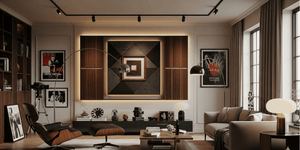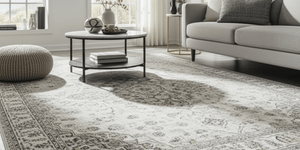Layering Texture in Your Space Using Curtains and Drapes

Layering Texture in Your Space Using Curtains and Drapes
Interior design may start with the walls and floors, but it ends in fabrics and textures. Every piece of furniture, throw pillow, and even artwork bring texture to your design. Layering those textures is what gives the space personality and warmth. A room without fabrics tends to look sterile and minimalist, while we associate a 'hominess' to rooms full of soft chairs, throw-pillows, and cheerful curtains. The perfect balance for your style be found somewhere in between.
While many homeowners have no trouble with selecting stylish furniture and arranging throw pillows, curtains are often a greater challenge. An important backdrop to your room design, they set the mood and define the style of your space. Yet few people are sure the best way to hang beautiful curtains that look just right with the proportions of each window and room.
So here's a quick guide on the best ways to choose, size, and position classically elegant drapes in any room. Here are the current drapery rules-of-thumb.
How to Layer Long Curtains and Drapes
Classic drapes have between two and four layers. Those layers can be sheer, blackout, and decorative interior and exterior. Most dual-rod systems have the sheer layer and combine the blackout and interior decorative layer.
The Sheer Diffuser
The single best trick of classic drape design is the sheer diffuser layer. This is a light, filmy curtain that is usually white or cream that hangs the full length and width of the window. Ideally, the diffuser mirrors your display drapes and acts as an elegant, lightweight texture in your room. When the sheer drapes are closed, they provide diffuse, warm sunlight but provide privacy for the family.
The Blackout Layer
The blackout layer is what makes drawing the drapes darken the room. Most people invest in either blackout-decorative curtains or layer their blackout curtain (often a plain solid color and nondescript fabric) on the same rod as their display curtain, moving them together.
The Decorative Layer
The decorative layer is your display curtain; the drapes that define your interior design style. Combined with the sheer and blackout curtains, you can choose any fabric that looks vivid or beautiful in your room design. Display drapes, however, often have a more visible weave with heavier threads, especially patterned drapes in classic designs.
Presentation Drapes
Some homes also add a final layer of drapes facing outward in order to shape their curbside appearance. While the inside of your home may have a unique design in every room, your exterior can look elegant and matching with more than just the sheer layer, if you choose.
Now let's talk about how and where to hang
The Right Height for Long Drapes
- Above the Window Frame: 4-6 Inches
- With a High Ceiling: 8 or fewer inches above window
- Extremely Tall Windows: Hang rods from the ceiling
- With Transoms and Arches: At the line or 4-6 inches above
How long should your drapes be? This is an very common question, as most people want elegant drapes but don't want their drapes to get dirty or look incorrect. The interior decorator standard is somewhere between 4 and 6 inches above the upper window frame. This gives you some room to check for studs and decide the best balance with the height of your ceiling.
What about unusual ceilings and windows? For tall ceilings, increase your margin by two inches, up to eight inches above the window frame. However, for windows that are very tall and nearly touch the ceiling, simply hang your curtain rods from the ceiling for an elegant floor-to-ceiling solution.
What about windows with arches or transoms? (A transom is an extra row of window-panes above the main window.) You can either hang your curtain rod at the line where the arch or transom starts, or hang it 4-6 inches above the top of the upper pane.
The Right Width for Curtains
- The Drapes: 3-6 Inches past the window frame
- Curtain Fabric: 2.5 times the window width
- The Curtain Rod: 1/3 wider than window or less
The next question is how wide your curtains should be from the window frame. Standard design practices suggest that your curtains, fluffy, should extend about 3-6 inches from the sides of your window, and the rod shouldn't be longer than 1/3 wider than the window, in total.
However, for curtains that fold elegantly, you'll want about 2.5 times the width of your window in curtain panels, whether you have one or two panels per window.
The Right Length for Long Drapes
- Stationary Drapes: puddled and arranged
- Moving Drapes: Brushing the floor
- Practical Elegance: 1 Inch above the floor
- Wall Furniture: Behind or just above the furniture
How long should your drapes extend to the floor, or should they touch the floor? Drapes are like ballgowns when it comes to length. For very elegant drapes that don't move much, puddling on the floor is considered very elegant. But they need to be arranged, are not mobile, and will need more regular washing if they drag.
Drapes that just brush the ground are a popular, practical compromise. If you can perfectly place your curtain rod so the drapes just barely don't touch the floor, they will sweep elegantly and smoothly for mobile and versatile drapes. For drapes that don't collect too much floor dust and are easy to quick-clean on the rod, hang your drapes one inch above the floor. But any higher, without being sill-height drapes, will seem like waders.
What about when furniture or radiators back up to drapes? You have two options, depending on how your room is arranged. You can either line your drapes exactly above the line of your furniture (or a safe distance above a radiator.)
Layering the Perfect Drapes for Your Design
The right drape design is a balance between what is practical in your home and elegant to look at. The sheer layer is great because it accomplishes both tasks, with very little weight on a rod, while your decorative layer can be anything you want. With a few standard rules on sizing and spacing, you can have elegant layered drapes in any room you design. Contact us today for more insights on personalizing your home.





